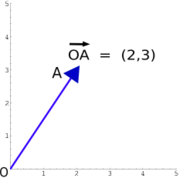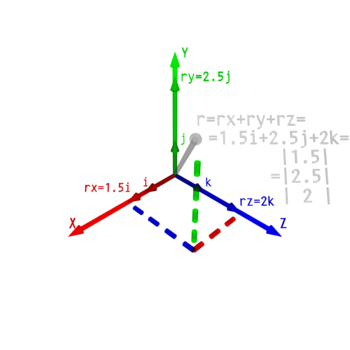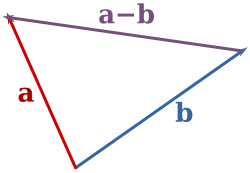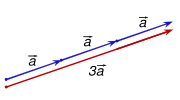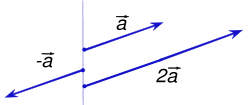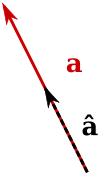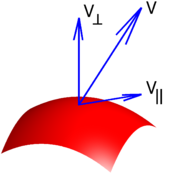Vector (spatial)
2008/9 Schools Wikipedia Selection. Related subjects: Mathematics; Physics
A spatial vector, or simply vector, is a geometric object which has both a magnitude and a direction. A vector is frequently represented by a line segment connecting the initial point A with the terminal point B and denoted
The magnitude is the length of the segment and the direction characterizes the displacement of B relative to A: how much one should move the point A to "carry" it to the point B.
Many algebraic operations on real numbers have close analogues for vectors. Vectors can be added, subtracted, multiplied by a number, and flipped around so that the direction is reversed. These operations obey the familiar algebraic laws: commutativity, associativity, distributivity. The sum of two vectors with the same initial point can be found geometrically using the parallelogram law. Multiplication by a positive number, commonly called a scalar in this context, amounts to changing the magnitude of vector, that is, stretching or compressing it while keeping its direction; multiplication by -1 preserves the magnitude of the vector but reverses its direction.
Cartesian coordinates provide a systematic way of describing vectors and operations on them. A vector becomes a triple of real numbers, its components. Addition of vectors and multiplication of a vector by a scalar are simply done component by component, see coordinate vector.
Vectors play an important role in physics: velocity and acceleration of a moving object and forces acting on a body are all described by vectors. Many other physical quantities can be usefully thought of as vectors. One has to keep in mind, however, that the components of a physical vector depend on the coordinate system used to describe it. Other vector-like objects that describe physical quantities and transform in a similar way under changes of the coordinate system include pseudovectors and tensors.
Overview
Informally, a vector is a quantity characterized by a magnitude (in mathematics a number, in physics a number times a unit) and a direction, often represented graphically by an arrow. Sometimes, one speaks of bound or fixed vectors, which are vectors whose initial point is the origin. This is in contrast to free vectors, which are vectors whose initial point is not necessarily the origin.
Use in physics and engineering
Vectors are fundamental in the physical sciences. They can be used to represent any quantity that has both a magnitude and direction, such as velocity, the magnitude of which is speed. For example, the velocity 5 meters per second upward could be represented by the vector (0,5). Another quantity represented by a vector is force, since it has a magnitude and direction. Vectors also describe many other physical quantities, such as displacement, acceleration, electric and magnetic fields, momentum, and angular momentum.
Vectors in Cartesian space
In Cartesian coordinates, a vector can be represented by identifying the coordinates of its initial and terminal point. For instance, the points A = (1,0,0) and B = (0,1,0) in space determine the free vector  pointing from the point x=1 on the x-axis to the point y=1 on the y-axis.
pointing from the point x=1 on the x-axis to the point y=1 on the y-axis.
Typically in Cartesian coordinates, one considers primarily bound vectors. A bound vector is determined by the coordinates of the terminal point, its initial point always having the coordinates of the origin O = (0,0,0). Thus the bound vector represented by (1,0,0) is a vector of unit length pointing from the origin up the positive x-axis.
The coordinate representation of vectors allows the algebraic features of vectors to be expressed in a convenient numerical fashion. For example, the sum of the vectors (1,2,3) and (-2,0,4) is the vector
Euclidean vectors and affine vectors
In the geometrical and physical settings, sometimes it is possible to associate, in a natural way, a length to vectors as well as the notion of an angle between two vectors. When the length of vectors is defined, it is possible to also define a dot product — a scalar-valued product of two vectors — which gives a convenient algebraic characterization of both length and angle. In three-dimensions, it is further possible to define a cross product which supplies an algebraic characterization of area.
However, it is not always possible or desirable to define the length of a vector in a natural way. This more general type of spatial vector is the subject of vector spaces (for bound vectors) and affine spaces (for free vectors).
Generalizations
In more general sorts of coordinate systems, rotations of a vector (and also of tensors) can be generalized and categorized to admit an analogous characterization by their covariance and contravariance under changes of coordinates.
In mathematics, a vector is considered more than a representation of a physical quantity. In general, a vector is any element of a vector space over some field. The spatial vectors of this article are a very special case of this general definition (they are not simply any element of Rd in d dimensions), which includes a variety of mathematical objects ( algebras, the set of all functions from a given domain to a given linear range, and linear transformations). Note that under this definition, a tensor is a special vector.
Representation of a vector
Vectors are usually denoted in boldface, as a. Other conventions include  or a, especially in handwriting. Alternately, some use a tilde (~) or a wavy underline drawn beneath the symbol, which is a convention for indicating boldface type.
or a, especially in handwriting. Alternately, some use a tilde (~) or a wavy underline drawn beneath the symbol, which is a convention for indicating boldface type.
Vectors are usually shown in graphs or other diagrams as arrows, as illustrated below:
Here the point A is called the initial point, tail, or base; point B is called the head, tip, or endpoint. The length of the arrow represents the vector's magnitude, while the direction in which the arrow points represents the vector's direction.
In the figure above, the arrow can also be written as  or AB.
or AB.
On a two-dimensional diagram, sometimes a vector perpendicular to the plane of the diagram is desired. These vectors are commonly shown as small circles. A circle with a dot at its centre indicates a vector pointing out of the front of the diagram, towards the viewer. A circle with a cross inscribed in it indicates a vector pointing into and behind the diagram. These can be thought of as viewing the tip an arrow front on and viewing the vanes of an arrow from the back.
In order to calculate with vectors, the graphical representation may be too cumbersome. Vectors in an n-dimensional Euclidean space can be represented in a Cartesian coordinate system. The endpoint of a vector can be identified with a list of n real numbers, sometimes called a row vector or column vector. As an example in two dimensions (see image), the vector from the origin O = (0,0) to the point A = (2,3) is simply written as
In three dimensional Euclidean space (or R3), vectors are identified with triples of numbers corresponding to the Cartesian coordinates of the endpoint (a,b,c). These numbers are often arranged into a column vector or row vector, particularly when dealing with matrices, as follows:
Another way to express a vector in three dimensions is to introduce the three basic coordinate vectors, sometimes referred to as unit vectors:
These have the intuitive interpretation as vectors of unit length pointing up the x, y, and z axis, respectively. In terms of these, any vector in R3 can be expressed in the form:
Note: In introductory physics classes, these three special vectors are often instead denoted i, j, k (or  when in Cartesian coordinates), but such notation clashes with the index notation and the summation convention commonly used in higher level mathematics, physics, and engineering. This article will choose to use e1, e2, e3.
when in Cartesian coordinates), but such notation clashes with the index notation and the summation convention commonly used in higher level mathematics, physics, and engineering. This article will choose to use e1, e2, e3.
The use of Cartesian unit vectors  as a basis in which to represent a vector, is not mandated. Vectors can also be expressed in terms of cylindrical unit vectors
as a basis in which to represent a vector, is not mandated. Vectors can also be expressed in terms of cylindrical unit vectors  or spherical unit vectors
or spherical unit vectors  . The latter two choices are more convenient for solving problems which possess cylindrical or spherical symmetry respectively.
. The latter two choices are more convenient for solving problems which possess cylindrical or spherical symmetry respectively.
Addition and scalar multiplication
Vector equality
Two vectors are said to be equal if they have the same magnitude and direction. However if we are talking about free vectors, then two free vectors are equal if they have the same base point and end point.
For example, the vector e1 + 2e2 + 3e3 with base point (1,0,0) and the vector e1+2e2+3e3 with base point (0,1,0) are different free vectors, but the same (displacement) vector.
Vector addition and subtraction
Let a=a1e1 + a2e2 + a3e3 and b=b1e1 + b2e2 + b3e3, where e1, e2, e3 are orthogonal unit vectors (Note: they only need to be linearly independent, i.e. not parallel and not in the same plane, for these algebraic addition and subtraction rules to apply)
The sum of a and b is:
The addition may be represented graphically by placing the start of the arrow b at the tip of the arrow a, and then drawing an arrow from the start of a to the tip of b. The new arrow drawn represents the vector a + b, as illustrated below:
This addition method is sometimes called the parallelogram rule because a and b form the sides of a parallelogram and a + b is one of the diagonals. If a and b are free vectors, then the addition is only defined if a and b have the same base point, which will then also be the base point of a + b. One can check geometrically that a + b = b + a and (a + b) + c = a + (b + c).
The difference of a and b is:
Subtraction of two vectors can be geometrically defined as follows: to subtract b from a, place the ends of a and b at the same point, and then draw an arrow from the tip of b to the tip of a. That arrow represents the vector a − b, as illustrated below:
If a and b are free vectors, then the subtraction is only defined if they share the same base point which will then also become the base point of their difference. This operation deserves the name "subtraction" because (a − b) + b = a.
Scalar multiplication
A vector may also be multiplied, or re-scaled, by a real number r. In the context of spatial vectors, these real numbers are often called scalars (from scale) to distinguish them from vectors. The operation of multiplying a vector by a scalar is called scalar multiplication. The resulting vector is:
Intuitively, multiplying by a scalar r stretches a vector out by a factor of r. Geometrically, this can be visualized (at least in the case when r is an integer) as placing r copies of the vector in a line where the endpoint of one vector is the initial point of the next vector.
If r is negative, then the vector changes direction: it flips around by an angle of 180°. Two examples (r = -1 and r = 2) are given below:
Scalar multiplication is distributive over vector addition in the following sense: r(a + b) = ra + rb for all vectors a and b and all scalars r. One can also show that a - b = a + (-1)b.
The set of all geometrical vectors, together with the operations of vector addition and scalar multiplication, satisfies all the axioms of a vector space. Similarly, the set of all bound vectors with a common base point forms a vector space. This is where the term "vector space" originated.
In physics, scalars may also have a unit of measurement associated with them. For instance, Newton's second law is
where F has units of force, a has units of acceleration, and the scalar m has units of mass. In one possible physical interpretation of the above diagram, the scale of acceleration is, for instance, 2 m/s2 : cm, and that of force 5 N : cm. Thus a scale ratio of 2.5 kg : 1 is used for mass. Similarly, if displacement has a scale of 1:1000 and velocity of 0.2 cm : 1 m/s, or equivalently, 2 ms : 1, a scale ratio of 0.5 : s is used for time.
Length and the dot product
Length of a vector
The length or magnitude or norm of the vector a is denoted by ||a|| or, less commonly, |a|, which is not to be confused with the absolute value (a scalar "norm").
The length of the vector a = a1e1 + a2e2+ a3e3 in a three-dimensional Euclidean space, where e1, e2, e3 are orthogonal unit vectors, can be computed with the Euclidean norm
which is a consequence of the Pythagorean theorem since the basis vectors e1 , e2 , e3 are orthogonal unit vectors.
This happens to be equal to the square root of the dot product of the vector with itself:
Vector length and units
If a vector is itself spatial, the length of the arrow depends on a dimensionless scale. If it represents e.g. a force, the "scale" is of physical dimension length/force. Thus there is typically consistency in scale among quantities of the same dimension, but otherwise scale ratios may vary; for example, if "1 newton" and "5 m" are both represented with an arrow of 2 cm, the scales are 1:250 and 1 m:50 N respectively. Equal length of vectors of different dimension has no particular significance unless there is some proportionality constant inherent in the system that the diagram represents. Also length of a unit vector (of dimension length, not length/force, etc.) has no coordinate-system-invariant significance.
Unit vector
A unit vector is any vector with a length of one; geometrically, it indicates a direction but no magnitude. If you have a vector of arbitrary length, you can divide it by its length to create a unit vector. This is known as normalizing a vector. A unit vector is often indicated with a hat as in â.
To normalize a vector a = [a1, a2, a3], scale the vector by the reciprocal of its length ||a||. That is:
Null vector
The null vector (or zero vector) is the vector with length zero. Written out in coordinates, the vector is (0,0,0), and it is commonly denoted  , or 0, or simply 0. Unlike any other vector, it does not have a direction, and cannot be normalized (i.e., there is no unit vector which is a multiple of the null vector). The sum of the null vector with any vector a is a (i.e., 0+a=a).
, or 0, or simply 0. Unlike any other vector, it does not have a direction, and cannot be normalized (i.e., there is no unit vector which is a multiple of the null vector). The sum of the null vector with any vector a is a (i.e., 0+a=a).
Dot product
- Main article: Dot product
The dot product of two vectors a and b (sometimes called the inner product, or, since its result is a scalar, the scalar product) is denoted by a ∙ b and is defined as:
where ||a|| and ||b|| denote the norm (or length) of a and b, and θ is the measure of the angle between a and b (see trigonometric function for an explanation of cosine). Geometrically, this means that a and b are drawn with a common start point and then the length of a is multiplied with the length of that component of b that points in the same direction as a.
The dot product can also be defined as the sum of the products of the components of each vector:
where a and b are vectors of n dimensions; a1, a2, …, an are coordinates of a; and b1, b2, …, bn are coordinates of b.
This operation is often useful in physics; for instance, work is the dot product of force and displacement.
Cross product
The cross product (also called the vector product or outer product) differs from the dot product primarily in that the result of the cross product of two vectors is a vector. While everything that was said above can be generalized in a straightforward manner to more than three dimensions, the cross product is only meaningful in three dimensions, although the seven dimensional cross product is similar in some respects. The cross product, denoted a × b, is a vector perpendicular to both a and b and is defined as:
where θ is the measure of the angle between a and b, and n is a unit vector perpendicular to both a and b. The problem with this definition is that there are two unit vectors perpendicular to both b and a.
The vector basis e1, e2 , e3 is called right-handed, if the three vectors are situated like the thumb, index finger and middle finger (pointing straight up from your palm) of your right hand. Graphically the cross product can be represented by the figure on the right.
The cross product a × b is defined so that a, b, and a × b also becomes a right-handed system (but note that a and b are not necessarily orthogonal). This is the right-hand rule.
The length of a × b can be interpreted as the area of the parallelogram having a and b as sides.
For arbitrary choices of spatial orientation (i.e., allowing for left-handed as well as right-handed coordinate systems) the cross product of two vectors is a pseudovector instead of a vector (see below).
Scalar triple product
The scalar triple product (also called the box product or mixed triple product) is not really a new operator, but a way of applying the other two multiplication operators to three vectors. The scalar triple product is sometimes denoted by (a b c) and defined as:
It has three primary uses. First, the absolute value of the box product is the volume of the parallelepiped which has edges that are defined by the three vectors. Second, the scalar triple product is zero if and only if the three vectors are linearly dependent, which can be easily proved by considering that in order for the three vectors to not make a volume, they must all lie in the same plane. Third, the box product is positive if and only if the three vectors a, b and c are right-handed.
In components (with respect to a right-handed orthonormal basis), if the three vectors are thought of as rows (or columns, but in the same order), the scalar triple product is simply the determinant of the 3-by-3 matrix having the three vectors as rows. The scalar triple product is linear in all three entries and anti-symmetric in the following sense:
Vector components
A component of a vector is the influence of that vector in a given direction. Components are themselves vectors.
A vector is often described by a fixed number of components that sum up into this vector uniquely and totally. When used in this role, the choice of their constituting directions is dependent upon the particular coordinate system being used, such as Cartesian coordinates, spherical coordinates or polar coordinates. For example, axial component of a vector is such that its component whose direction is determined by one of the Cartesian coordinate axes, whereas radial and tangential components relate to the radius of rotation of an object as their direction of reference. The former is parallel to the radius and the latter is orthogonal to it. Both remain orthogonal to the axis of rotation at all times. (In two dimensions this requirement becomes redundant as the axis degenerates to a point of rotation.) The choice of a coordinate system doesn't affect properties of a vector or its behaviour under transformations.
Vectors as directional derivatives
A vector may also be defined as a directional derivative: consider a function f(xα) and a curve xα(τ). Then the directional derivative of f is a scalar defined as

where the index α is summed over the appropriate number of dimensions (e.g. from 1 to 3 in 3-dimensional Euclidian space, from 0 to 3 in 4-dimensional spacetime, etc.). Then consider a vector tangent to xα(τ):

We can rewrite the directional derivative in differential form (without a given function f) as

Therefore any directional derivative can be identified with a corresponding vector, and any vector can be identified with a corresponding directional derivative. We can therefore define a vector precisely:
Vectors, pseudovectors, and transformations
An alternative characterization of spatial vectors, especially in physics, describes vectors as lists of quantities which behave a certain way under a coordinate transformation. A vector is required to have components that "transform like the coordinates" under coordinate rotations. In other words, if all of space were rotated, the vector would rotate in exactly the same way. Mathematically, if the coordinate system undergoes a rotation described by a rotation matrix R, so that a coordinate vector x is transformed to x′ = Rx, then any other vector v must be similarly transformed via v′ = Rv. This important requirement is what distinguishes a spatial vector from any other triplet of physically meaningful quantities. For example, if v consists of the x, y, and z-components of velocity, then v is a vector because the components of the velocity transform under coordinate changes. On the other hand, for instance, a triplet consisting of the length, width, and height of a rectangular box could be regarded as the three components of an abstract vector, but not a spatial vector, since rotating the box does not correspondingly transform these three components. Examples of vectors include displacement, velocity, electric field, momentum, force, and acceleration.
In the language of differential geometry, the requirement that the components of a vector transform according to the same matrix of the coordinate transition is equivalent to defining a vector to be a tensor of contravariant rank one. However, in differential geometry and other areas of mathematics such as representation theory, the "coordinate transitions" need not be restricted to rotations. Other notions of spatial vector correspond to different choices of symmetry group.
As a particular case where the symmetry group is important, all of the above examples are vectors which "transform like the coordinates" under both proper and improper rotations. An example of an improper rotation is a mirror reflection. That is, these vectors are defined in such a way that, if all of space were flipped around through a mirror (or otherwise subjected to an improper rotation), that vector would flip around in exactly the same way. Vectors with this property are called true vectors, or polar vectors. However, other vectors are defined in such a way that, upon flipping through a mirror, the vector flips in the same way, but also acquires a negative sign. These are called pseudovectors (or axial vectors), and most commonly occur as cross products of true vectors.
One example of an axial vector is angular momentum. Driving in a car, and looking forward, each of the wheels has an angular momentum vector pointing to the left. If the world is reflected in a mirror which switches the left and right side of the car, the reflection of this angular momentum vector points to the right, but the actual angular momentum vector of the wheel still points to the left, corresponding to the minus sign. Other examples of pseudovectors include magnetic field, torque, or more generally any cross product of two (true) vectors.
This distinction between vectors and pseudovectors is often ignored, but it becomes important in studying symmetry properties. See parity (physics).





